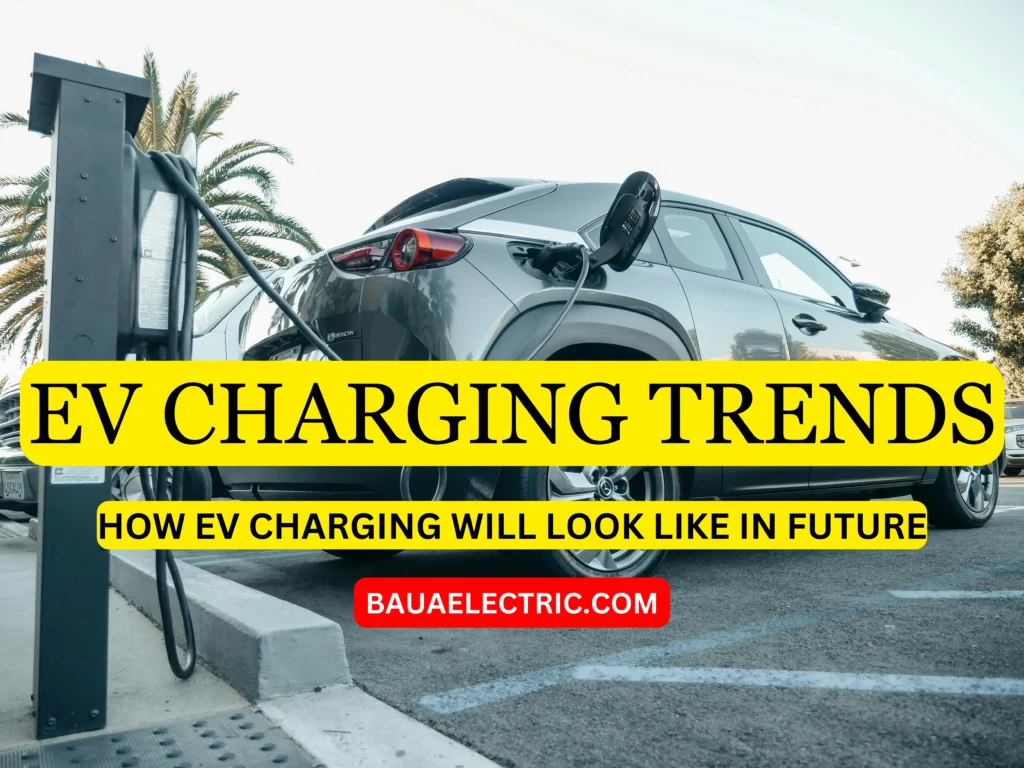The future of electric vehicle (EV) charging is expected to undergo significant changes and improvements. While the specifics can evolve, here are some trends and potential developments that could shape the future of EV charging:
- Faster Charging Speeds:
- Advances in charging technology are likely to result in even faster charging speeds. High-power chargers, such as 350 kW chargers, are becoming more widespread, reducing charging times significantly.
- Extended Range and Energy Density:
- Ongoing developments in battery technology could lead to EVs with longer ranges and higher energy density. This, coupled with faster charging, would enhance the overall convenience and usability of electric vehicles.
- Ubiquitous Charging Infrastructure:
- Expect further expansion of EV charging infrastructure, making it more widespread and accessible. This includes public charging stations in urban areas, along highways, at workplaces, and in residential areas.
- Smart Charging Networks:
- Smart charging solutions will likely become more prevalent. These systems can optimize charging times based on factors such as grid demand, electricity prices, and individual user preferences. Integration with smart home systems and mobile apps may also become more seamless.
- Wireless Charging Integration:
- Wireless charging technology is expected to play a role in the future of EV charging. This could involve wireless charging pads embedded in parking spaces, enabling convenient and cable-free charging.
- Renewable Energy Integration:
- Increased integration of EV charging infrastructure with renewable energy sources is likely. Solar-powered charging stations and other sustainable energy solutions could contribute to reducing the environmental impact of EVs.
- Energy Storage and Grid Integration:
- EVs may play a role in energy storage and grid balancing. Vehicle-to-Grid (V2G) technology could allow EVs to discharge energy back to the grid during peak demand periods, contributing to grid stability.
- Standardization and Interoperability:
- Efforts to standardize charging connectors and protocols will likely continue, ensuring interoperability between different EV models and charging stations. This will make it easier for users to charge their vehicles at any compatible station.
- Innovations in Payment Systems:
- Innovations in payment systems for charging services may enhance the user experience. This could involve seamless and secure payment methods, such as mobile apps or integrated payment systems within the vehicle.
- Improved User Experience:
- The overall user experience of EV charging is likely to improve, with more user-friendly interfaces, better signage, and improved reliability of charging infrastructure.
- Advanced Materials and Durability:
- Innovations in materials and design may lead to more durable and efficient charging equipment. This could include chargers that are resistant to harsh weather conditions and have longer lifespans.
- Government Support and Policies:
- Continued government support, incentives, and policies promoting EV adoption and charging infrastructure development will play a crucial role in shaping the future of EV charging.
innovations going on ev charging
There are many innovations going on ev charging field some of the important innovations that are ramping are highlighted below.
- Ultra-Fast Charging:
- Research and development efforts were focused on achieving ultra-fast charging capabilities, with charging stations capable of delivering power in the range of 350 kW or more. This could significantly reduce the time required for charging.
- Solid-State Batteries:
- Advances in battery technology, particularly the development of solid-state batteries, have the potential to impact EV charging. Solid-state batteries offer benefits such as higher energy density, faster charging rates, and improved safety.
- Bidirectional Charging (V2G):
- Vehicle-to-Grid (V2G) technology allows EVs not only to draw energy from the grid but also to feed energy back into it. This bidirectional charging capability has the potential to support grid stability and provide additional revenue streams for EV owners.
- Wireless Charging:
- Wireless charging technology for EVs continues to progress. This involves charging pads embedded in parking spaces or even charging while driving on specially equipped roads. Convenience and ease of use are key goals of wireless charging innovations.
- High-Efficiency Charging Infrastructure:
- Efforts were being made to improve the efficiency of charging infrastructure, reducing energy losses during the charging process. This includes optimizing the design of charging stations and utilizing advanced power electronics.
- Smart Charging Solutions:
- Integration of smart charging solutions, where charging times and rates are optimized based on factors such as energy demand, grid conditions, and user preferences. This can enhance the efficiency of the charging process.
- Advanced Materials for Charging Equipment:
- Innovations in materials used in charging equipment to enhance durability, efficiency, and performance. This includes corrosion-resistant materials and components that can withstand various environmental conditions.
- Blockchain Technology for Charging Transactions:
- Some projects were exploring the use of blockchain technology to secure and streamline transactions in EV charging. This can enhance the security and transparency of payment processes.
- AI and Machine Learning for Charging Optimization:
- The application of artificial intelligence (AI) and machine learning to optimize charging processes. These technologies can analyze data to predict usage patterns, recommend optimal charging times, and improve the overall efficiency of charging infrastructure.
- Public-Private Partnerships:
- Collaborations between public and private entities to expand and improve EV charging infrastructure. Public-private partnerships can accelerate the deployment of charging stations and make them more accessible to a broader population.
- Energy Storage Integration:
- Integration of energy storage systems with charging infrastructure to manage demand peaks and provide a more stable power supply. This can contribute to grid stability and reduce stress during high-demand periods.
- Environmental Sustainability Initiatives:
- Some innovations focus on making EV charging more environmentally sustainable. This includes the use of renewable energy sources to power charging stations and eco-friendly materials in the construction of charging infrastructure.
It’s important to note that the evolution of EV charging will depend on technological advancements, regulatory frameworks, and market dynamics. Keeping abreast of the latest developments in the electric vehicle industry will provide a more accurate picture of what the future of EV charging may look like.



